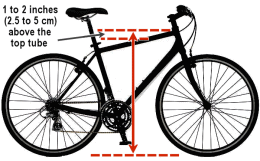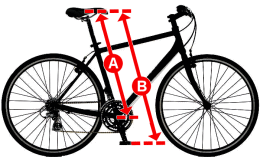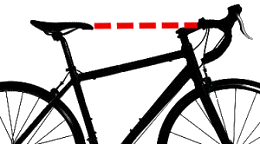Good Bike Fit Fundamentals
Good Bike-Fit for Comfortable
and Pain-free Cycling
Proper bike fit is especially important for people who cycle on a regular basis or ride longer distances. Without it, cycling can be uncomfortable, and even downright painful. Although many people don’t realize it, poor bike fit is often at the root of whatever afflictions that may be keeping them from doing more cycling.
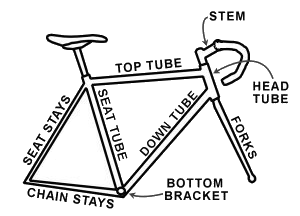
This is particularly true for individuals who have convinced themselves that, unlike most other people, they are not suited to cycling because they suffer aches or pains every time they go for a ride. In most cases, all they need is some “basic” bike fit to become full fledged cyclists.
Even experienced cyclists can sometimes give up on their bikes because of sore joints and general discomfort that they may experience as they grow older, or as the symptoms of a particular physiological condition become more pronounced (e.g. the results of one leg being a touch shorter than the other). More often than not, their problems can be eliminated with a few advanced techniques for obtaining optimal bike-fit.
Although the starting-point for getting a good bike fit isn’t overly complicated, there can be a lot of variables in getting it just right. As a result, this article can only scratch the surface of what you should look out for. It should also be noted that much of what is presented here is relevant to both hybrids and road bikes, but not necessarily mountain bikes.
Bicycle frame size
An easy way to judge if a bicycle is the right size for you is to stand over it and ensure that there is 1 to 2 inches (2.5 to 5 cm) of clearance between the frame’s top tube and your crotch. |
Proper frame size
It will come as no surprise that good bike fit starts with the proper frame size. This shouldn’t be a problem when buying a new bicycle at a reputable bike shop. They should provide you with the proper frame size, although people who are very short or exceptionally tall may want to shop around to make sure they are getting exactly what they need. When buying a pure road bike, women may also want to look at “women specific” frame sizes. These tend to have a shorter top tube, and will provide many women (not all) with a more conformable riding position than would be the case with a standard frame (usually designed with men in mind).
If you are buying used or inheriting a bike from someone, you’ll be on your own for determining if you are getting the right frame size. A quick and dirty way of doing this is to ensure that there is 1 to 2 inches (2.5 to 5 cm) of clearance between the frame’s top tube and your crotch when standing over the bike. An easy way to do this is to stand over the bike, lift it up until the top tube comes up firmly into contact with your crotch, and then check to see if the bike’s wheels are 1 to 2 inches off the ground.
The accompanying chart provides a very rough idea of which frame size might work for you. Bear in mind that every manufacturer has its own way of designing and measuring bicycle frames, so no chart or formula can be 100% accurate in determining what’s right for you. It should also be noted that traditionally, road bike sizes are determined by the length of the seat tube (usually stated in centimetres). However, this only works for bikes with a classic frame geometry, where the top tube is more or less parallel to the ground. It doesn’t work with bikes that are built with the so-called compact frame geometry. These have a smaller frame triangle, a downward sloping top tube, and a shorter seat tube. As a result, compact frame sizes are often stated in terms of XS, S, M, L, and XL.
Inseam measurement
Don’t use your pant’s inseam for bike fitting purposes. The best way to get an accurate measurement of your inseam is to stand bare feet with your back against a wall. Put a carpenter’s square or narrow book between your legs and raise it snug against your crotch. Keep the book square to the wall. Have someone measure in centimetres the distance from the top edge of the book to the floor. It may be a little more accurate to mark the wall at the top edge of the book, and then measure the distance between the mark and the floor. You should now have a good inseam measurement for bike fitting purposes. |
Initial bike setup
Starting off with the correct frame size is important, but is meaningless by itself unless the necessary adjustments are made to ensure the bike will fit just right. In fact, it is the outcome of this process that people are usually referring to when talking about good “bike fit”.
If you are buying a new bicycle, a reputable shop will make the necessary adjustments that provide you “basic” bike-fit. Experienced staff can do this very quickly. Nevertheless, if you feel they are being overly hasty, or if the person serving you doesn’t seem sure of him or herself, insist that a qualified individual take the time to assets your riding position and make the necessary adjustments.
If you’re buying a used bike, you’ll have to start from scratch when making adjustments that will work for you. The methods described below should provide you a “basic” bike-fit. These methods should be considered as a starting point, and there is some room for some variation in settings to accommodate individual riding styles and physiques. However, if you end up with something that is wildly different than what is being suggested here, there’s probably a problem with your bike’s setup.
Getting the right seat height
Your bike’s seat (saddle) should be high enough so that your leg will be almost fully extended (with a slight bend at the knee) when the pedal is at the lowest point during its downward stroke. Here are a few approaches for trying to figure things out.
Heel on the pedal. This technique involves sitting on the seat with your hips level with the ground (when viewed from behind). The height of the seat should be set so that your leg will be fully extended (no bend at the knee) when your heel in on the pedal when it is at its lowest point on the downward stroke. When cycling, you should have the ball of your foot on the pedal, and this will ensure that there is a slight bend at the knee when your leg is almost fully extended during the down stroke.
Seat Height Formulas When working in centimetres, multiply your leg’s inseam by 0.883 to figure out the distance represented by line “A” (between the top of the seat and the bicycle’s bottom bracket). Alternatively, multiply your inseam by 1.09 to determine the distance represented by line “B” (between the top of the seat and the top of the pedal when it is at its lowest point). |
Inseam formulas. To use these formulas, you’ll have to accurately measure your leg’s inseam in centimeters (see the side bar on how to do this). According to the Greg Lemond formula, you simply multiply your inseam by 0.883 to find out the distance in centimetres between the top of the seat and the centre point of the bicycle’s bottom bracket (the centre point of the axle to which the pedal arms are attached). Another popular formula involves multiplying your inseam by 1.09 to determine the distance in centimetres between the top of the seat and the top of the pedal when it is at its lowest point in the downward stroke.
No hip rocking. Here’s a simple technique to determine if your seat is too high. Have a friend ride behind you to see if you’re rocking your hips from side to side when pedaling. Tucking your cycling jersey into your shorts will provide a reference line across your lower back that will make it easier for your friend to see what’s happening. If you are rocking your hips, your seat is too high. How much it should be lowered will vary from person to person, but you can start by revisiting the technique and formulas described above to make the necessary adjustments.
Adjusting the seat’s fore/aft position
Once the height has been set, you can concentrate on adjusting the angle of the seat and its fore/aft position on the seat post. For most people the seat should be kept level, or parallel to the ground. However, some cyclists may find it a little more comfortable when the nose of the seat is angled down ever so slightly.
Adjusting the seat’s fore/aft position on the seat post is a bit more complicated and may require the assistance of a friend. The most cited technique for doing this (the KOPS method) involves sitting on the bike on a level surface with your foot on a pedal at the 3 o’clock position. Next, use a string with a small weight at the end and dangle it from the small indent immediately below your knee cap (see illustration). The string should come very close to intersecting the middle of the pedal (when viewed from the side by your friend). If not, adjust the seat by moving it forward or backward until it does.
Seat’s fore/aft position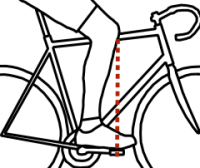 Sit on your bike with your foot on a pedal at the 3 o’clock position, and hang a string with a small weight at the end from your knee cap. Move the seat forward or backward until the string crosses the middle of the pedal. |
Note that there is a number of experts who argue that this technique may not be perfect for determining the seat position for some cyclists, but there is wide spread agreement that it is a good starting point for most people.
Setting the handlebar height
Setting the right height for the handlebars is probably the one adjustment that relies more on what’s comfortable than any specific technique or formula. It should also be noted that while a good number of hybrids come with adjustable stems for changing the height of the handlebars, many bikes do not. If your bike has a fixed (non-adjustable) stem, you may have to buy one with a different rise to set the handlebars at the desired height. When shopping for a new bike, ask about swapping the standard stem for something more to your liking. (Note that fixed stems are far more solid than the adjustable type.)
The general rule for adjusting handlebars is that they should be set above the height of the seat for a more upright and comfortable riding position, and below the height of the seat for a more forwarding-leaning, performance oriented position. How much will depend on your preference and what you are comfortable with. Road racing pros sometimes have their handlebars set 2 to 3 inches (5 to 8 cm) below the height of their seats, while people who want a totally upright riding position may have the handlebars set 2 to 3 inches higher than their seats.
If you’re looking for comfort that comes with more of an upright riding position, start off by setting your handlebars at roughly the same height as your seat, or maybe slightly higher. If this doesn’t work for you, try a little higher.
Handlebar Height The handlebars in this illustration are the same height as the seat, meaning that they would provide fairly comfortable riding position. |
Some beginners and recreational cyclists insist on setting their handlebars as high as possible so that they are able to ride in a totally upright seating position. Although there’s nothing really wrong with this when pedaling short distances at slow to moderate speeds, you will cycle more efficiently when there is some forward lean in your upper body (your torso). This doesn’t mean you have to be hunched way over. It’s really a question of finding a handlebar height that is comfortable for you. More often than not, this does not require a 100% upright sitting position.
Another consideration is that a totally upright position means your spinal column will absorb more vibrations and shocks that are transmitted from the bike when cycling over bumps. This may become noticeable on longer rides.
Fine tuning the “basic” bike fit
The adjustments described above are a good starting point for providing a “basic” bike fit. However, there is always room to tweak the bike’s initial setup to accommodate different riding styles and physiques. If you feel this is necessary, you should experiment a little. When doing so, make any changes in small increments (1/4 to 1/2 cm at a time), and ride at least a couple of kilometres before taking any decision on the new settings. Before starting, it’s always a good idea to mark the initial settings so that you’ll be able to return to them in case the new adjustments don’t work out.
Fine tuning your “basic” bike fit becomes even more important if you are experiencing general discomfort or some pain after longer rides. When doing so, you should be aware that there are a number adjustments that can be made in response to specific symptoms. For example, if you’re getting a sore neck or back pain, try raising the handlebars a bit. It’s also possible the “reach” to your handlebars may too long. You can correct this by installing a shorter stem that will move the handlebar back closer to the steering column.
Knee pain can come in three varieties. If you are experience pain on the outside side of your knee, it’s probably due to Iliotibial band syndrome. Try lowering the seat, and maybe moving it a little more forward, or a combination of both these adjustments. Pain in the front part of the knee can often be dealt with by raising the seat , and maybe moving it backward a bit, or a combination of both. If you’re encountering pain in the back part of the knee, you should experiment with lowering the seat.
Sore hamstring is often associated with pain in the back of the knee, and usually means the seat should be lowered. Hip pain can be related to several issues, but lowering the seat could help with this problem.
Advanced bike-fit considerations
For many people (perhaps the majority of us), this “basic” bike-fit is all they’ll need to enjoy years of comfortable and pain-free cycling. However, if after completing the adjustments and fine tuning described above, you are still experiencing pain and discomfort, you may be a candidate for some advanced bike-fitting techniques. This could be the case with any cyclist, but it may be more relevant for people who are getting on in age or may have a particular physiological condition.
When contemplating the need for advanced bike-fitting techniques, remember that the bicycle is a symmetrical machine, and the human body is surprisingly asymmetrical. Although we rarely notice it, most people tend to have one leg that is slightly shorter than the other, one foot that points out more than the other, a muscle group that’s a little tighter on one side than the other, or even a spine with a slight curve to one side or the other. All this means that we exert and strain our muscles and joints differently on one side than the other. For some people, this can cause aches pains can to suddenly flare up, especially after longer rides.
Sometimes it only take a very small asymmetry to cause pain and discomfort. If you doubt this, consider that some professional cyclists will go so far as to have their legs x-rayed in order to obtain the most precise measurement possible when determining which leg is longer than the other.
Applying advanced bike-fit techniques
It is beyond the scope of this article (and the expertise of the author) to provide meaningful advice about advanced bike-fitting techniques. You may find some useful information on this subject by conducting in depth research on the internet. However, the best way to get a bike-fit based on advanced techniques is to go see a professional.
These professionals are highly specialized and have the necessary knowledge and equipment to provide optimal bike fit. Their expertise goes well beyond what can be found at the average bike shop. For example, they can often spot the small asymmetrical difference in someone’s body by simply watching them pedal their bicycle. Because bike-fitting is at the core of what they do, they usually operate their own business, and are not necessarily part of a bike shop (although there are some exceptions).
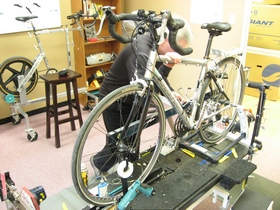
Bike fitting expert working on a bicycle.
A professional bike fitting can take up to two to three hours, even longer for some challenging cases. In addition to making the usual adjustments, they may also employ advanced techniques such as raising the height of one pedal, using a wedge to change the angle at which the foot sits on a pedal, adjusting the spacing between the two pedals, installing a stem that provides both the perfect height and reach for the handlebars, and so on. Each has their own approach for going about their work, and some (not all) make use of sophisticated equipment such as lasers to take precise measurements, or video camera and computer to conduct motion analysis.
Finding a professional bike fitter
Since anyone can call themselves a professional bike fitter, finding one that is truly qualified is not always a simple matter. Their expertise can come from years of experience, specialized training, or a combination of both. As a result, you’ll probably have to figure things out by asking around and seeing what bike fitters have to say on their websites. Ultimately, you may want to talk to several bike fitters to ask them about their qualifications, the type of service they offer, and their philosophy for providing optimal bike fit.
When looking for a professional bike fitter, you should be aware that some may be a better choice for competitive cyclists and triathletes, while others may be more suitable for people who do a lot of recreational cycling and bicycle touring. You should also be cautious with individuals at a few bike shops who take a quick bike-fitting course and equip themselves with fancy looking measuring jigs. Most of these people will be capable a providing a “basic” bike fit, but not much more. Unfortunately, some of them will try to pass themselves off as experts in advanced bike fitting techniques, and will charge overinflated fees.
The cost for an in depth fitting session by a qualified professional can run from $150 to $250 (prices as of 2011). The exact amount will be determined by the fitter pricing structure and the exact services being provided. Some people may balk at paying so much for what they perceive as a few simple adjustments. A better way to look at it is that this small investment that will allow you to enjoy the benefits of comfortable and pain-free cycling for the next ten or twenty years of your life.
Aches and pains unrelated to bike fit
Cyclists can experience sore joints and muscles that are not necessarily related to bike fit issues. Although not the focus of this article, the following is a quick overview of some of the things to look out for.
![]() Over doing it. Your bike may have been adjusted for a very good fit, but if you go for a ride that’s 3 or 4 times longer than what you’re used to, there’s an excellent chance you’ll end up with sore joints and muscles. There’s also the question of maintaining a certain level of fitness for cycling. For example, back pain can sometime be eliminated with exercises to strengthen your core muscles (old fashion sit ups, crunches, the boat pose, etc).
Over doing it. Your bike may have been adjusted for a very good fit, but if you go for a ride that’s 3 or 4 times longer than what you’re used to, there’s an excellent chance you’ll end up with sore joints and muscles. There’s also the question of maintaining a certain level of fitness for cycling. For example, back pain can sometime be eliminated with exercises to strengthen your core muscles (old fashion sit ups, crunches, the boat pose, etc).
![]() Pain in the front part of the knee can sometimes be caused by cycling in too high a gear. Many people feel that it’s very natural to pedal at 60 to 70 rpm (rpm is often referred to as “cadence” in cycling) . However, your knees will do better and you’ll cycle more efficiently by selecting a lower gear that allows you to pedal at 80 rpm (or higher). Premium cycling computers provide cadence information, but these can get expensive. Otherwise, you could get in the habit of selecting a gear where you will be rotating your pedals slightly faster than what would feel normal.
Pain in the front part of the knee can sometimes be caused by cycling in too high a gear. Many people feel that it’s very natural to pedal at 60 to 70 rpm (rpm is often referred to as “cadence” in cycling) . However, your knees will do better and you’ll cycle more efficiently by selecting a lower gear that allows you to pedal at 80 rpm (or higher). Premium cycling computers provide cadence information, but these can get expensive. Otherwise, you could get in the habit of selecting a gear where you will be rotating your pedals slightly faster than what would feel normal.
![]() You could end up with a sore butt and very painful blisters if your bicycle seat (saddle) is too hard, too soft, or simply mismatched to your anatomy. Beginners often want the softest seat possible because these feel more comfortable when your first get on them. However, sitting on such seat causes its soft structure to bulge out in different places, and this can lead to chafing and blisters on longer rides. So get a good seat, and remember that if you’re prone to saddle sores, anti-chafing creams (chamois creams) can be effective at preventing the blisters and reducing pain in sensitive areas.
You could end up with a sore butt and very painful blisters if your bicycle seat (saddle) is too hard, too soft, or simply mismatched to your anatomy. Beginners often want the softest seat possible because these feel more comfortable when your first get on them. However, sitting on such seat causes its soft structure to bulge out in different places, and this can lead to chafing and blisters on longer rides. So get a good seat, and remember that if you’re prone to saddle sores, anti-chafing creams (chamois creams) can be effective at preventing the blisters and reducing pain in sensitive areas.
![]() Riding with your elbows locked so that you arms are in a fully extended position can lead to sore neck and shoulders, or pain in your upper back. You should keep a slight bend in the elbows so that your arms will be able to absorb the vibration and shocks that are transmitted from the handlebars.
Riding with your elbows locked so that you arms are in a fully extended position can lead to sore neck and shoulders, or pain in your upper back. You should keep a slight bend in the elbows so that your arms will be able to absorb the vibration and shocks that are transmitted from the handlebars.
![]() Your feet will scream for relief if you spend any amount of time riding with the arch of your foot directly over the pedal, especially when wearing shoes with a soft sole. You feet will be much happier and you’ll cycle more efficiently by placing the ball of your foot on the pedal. Inexpensive plastic “toe clips” will help you keep your foot properly positioned. (If the toe clips have straps, leave them very loose so that you can easily insert and remove your foot.)
Your feet will scream for relief if you spend any amount of time riding with the arch of your foot directly over the pedal, especially when wearing shoes with a soft sole. You feet will be much happier and you’ll cycle more efficiently by placing the ball of your foot on the pedal. Inexpensive plastic “toe clips” will help you keep your foot properly positioned. (If the toe clips have straps, leave them very loose so that you can easily insert and remove your foot.)
![]() Even with the proper placement on the pedal, some people will get a burning sensation under their feet when cycling long distances. Loosening your shoes and maybe getting larger footwear can help eliminate this problem (your feet tend to flatten out and expand when pedaling for long periods). Moreover, anything that will better distribute the load of your foot over the entire pedal surface can also help with this problem. If you’re using regular footwear (running shoes, etc) look for something with with the stiffest soles you can possibly find.
Even with the proper placement on the pedal, some people will get a burning sensation under their feet when cycling long distances. Loosening your shoes and maybe getting larger footwear can help eliminate this problem (your feet tend to flatten out and expand when pedaling for long periods). Moreover, anything that will better distribute the load of your foot over the entire pedal surface can also help with this problem. If you’re using regular footwear (running shoes, etc) look for something with with the stiffest soles you can possibly find.
![]() Hand numbness is another problem that can plague cyclists on longer rides. Padded bicycle gloves and changing you hand position on the handlebars at regular intervals should get rid of this problem. There are a limited number of holding positions on the type of handlebars found on hybrids and mountain bikes. Adding inexpensive “bar ends” on these bikes will give you an additional holding position.
Hand numbness is another problem that can plague cyclists on longer rides. Padded bicycle gloves and changing you hand position on the handlebars at regular intervals should get rid of this problem. There are a limited number of holding positions on the type of handlebars found on hybrids and mountain bikes. Adding inexpensive “bar ends” on these bikes will give you an additional holding position.
Michael McGoldrick
May, 2011
[feather_share]
Some handy links:these bike fitters, but they are listed here as an example of places to start looking if you need advanced bike fitting services in the Ottawa-Gatineau area. ► G.M. Bertrand Bicycle Fitting A good YouTube video on bike fitting: |

